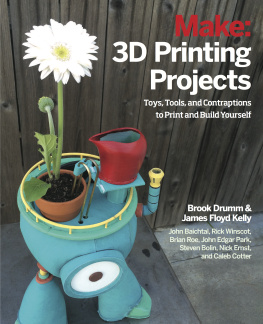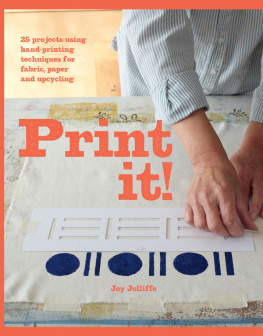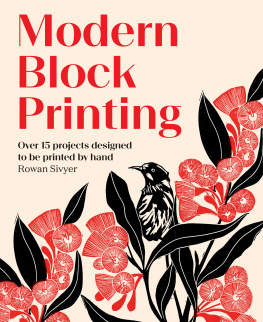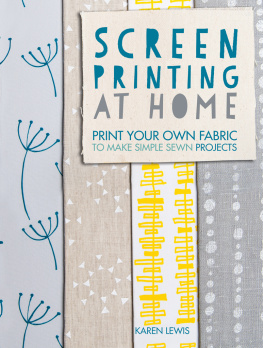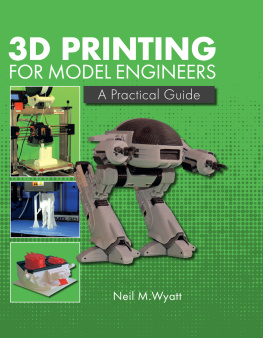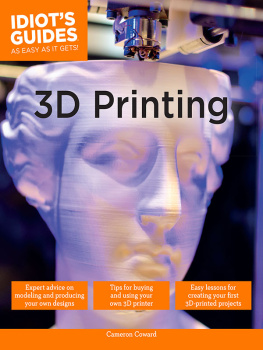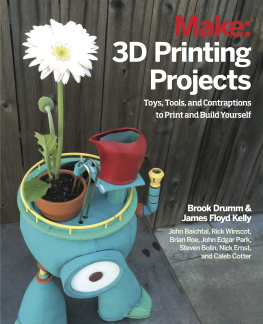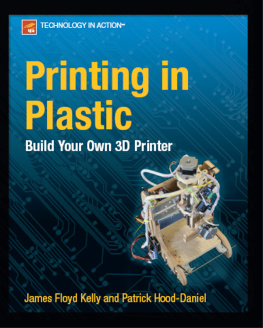Make: 3D Printing Projects
by Brook Drumm , James Floyd Kelly , John Edgar Park , Brian Roe , John Baichtal , Rick Winscot , Steven Bolin Nick Ernst , and Caleb Cotter
Copyright 2016 Brook Drumm, James Floyd Kelly, John Edgar Park, Brian Roe, John Baichtal, Steven Bolin, Rick Winscot, Nick Ernst, and Caleb Cotter. All rights reserved.
Printed in Canada.
Published by Maker Media, Inc. , 1160 Battery Street East, Suite 125, San Francisco, CA 94111.
Maker Media books may be purchased for educational, business, or sales promotional use. Online editions are also available for most titles (http://safaribooksonline.com). For more information, contact our corporate/institutional sales department: 800-998-9938 or corporate@oreilly.com .
- Editor: Anna Kaziunas France
- Production Editor: Nicholas Adams
- Copyeditor: Charles Roumeliotis
- Proofreader: Kim Cofer
- Indexer: Wendy Catalano
- Interior Designer: David Futato and Anna Kaziunas France
- Cover Designer: Anna Kaziunas France
- Illustrator: Rebecca Demarest
- October 2015: First Edition
Revision History for the First Edition
- 2015-10-02: First Release
See http://oreilly.com/catalog/errata.csp?isbn=9781457187247 for release details.
The Make logo is a registered trademark of Maker Media, Inc. Make: 3D Printing Projects, the cover image, and related trade dress are trademarks of Maker Media, Inc.
Many of the designations used by manufacturers and sellers to distinguish their products are claimed as trademarks. Where those designations appear in this book, and Maker Media, Inc., was aware of a trademark claim, the designations have been printed in caps or initial caps.
While the publisher and the authors have used good faith efforts to ensure that the information and instructions contained in this work are accurate, the publisher and the authors disclaim all responsibility for errors or omissions, including without limitation responsibility for damages resulting from the use of or reliance on this work. Use of the information and instructions contained in this work is at your own risk. If any code samples or other technology this work contains or describes is subject to open source licenses or the intellectual property rights of others, it is your responsibility to ensure that your use thereof complies with such licenses and/or rights.
978-1-4571-8724-7
[TI]
Preface
Its time to stop treating 3D printers like standalone machinestheyre just another tool in your toolbox.
Youre holding a book full of projects, ranging from simple and utilitarian to the utterly fantastical. While these projects require a 3D printer to produce custom parts, each utilizes a unique combination of electronics, hand assembly techniques, and additional tools, parts, and software. The printer is a custom fabrication enabler, but its what you create with it that matters.
Because weve rejected the hype that puts the printer on a pedestal and embraced the another tool philosophy, weve found our printers to continue to prove themselves time-saving, multifaceted machines. By reducing the amount of time spent in front of traditional tools, they speed our making. Why drill a 1/4 hole in a small component when you can design the part with the hole already properly and accurately placed?
The additive process also saves us time, money, and pain. Hobbyists who use wood or aluminum for their mock-ups spend a good portion of their time measuring, cutting, and drilling. As mistakes are made or small modifications must be incorporated, they often have to start again from scratch. And again. And again.
This cycle is dramatically shortened when you design in software, test print, tweak, then reprint, as exemplified in by the Raygun Pen projects pile of prototyped handles. A new piece can be printing while you work on another aspect of your project, or engage in something more mundane, like doing the dishes or mowing the lawn.
But a 3D printer cant do it all. If your project needs some LED lighting or motors added, those cant be printed up, wired, and soldered together to create a final product.
Perhaps youve had a 3D printer for some time now, or were looking for a reason to buy one, but the Yoda head figurines are no longer novel. Your machine may even be sitting in the corner, gathering dust. We say its time to put that printer back to work!
Each design in this book was envisioned, lovingly prototyped, and assembled by a unique individual. Together, they exemplify the broad range of highly personalized, limit-pushing project possibilities enabled by the printing of parts, fusion of tools, and wide availability of affordable electronic components.
Even if youve never touched a printer, we hope these projects excite and embolden you to learn new skills, extend your current abilities, and awaken your creative impulses. If youre inspired to go make something after reading this book, then weve done our job.
Brook Drumm, Founder and CEO of Printrbot
James Floyd Kelly, Writer. Maker. Adventurer
What You Need to Know
This book takes a step-by-step approach to projects, but it does assume that you understand how to solder and know a little about electronics. If these things are new to you, there are resources widely available on the Internet (we link to many of them in the projects) and Maker Media has published many books on these subjects.
Project Files and Code
Every project in this book was designed to fit on a Printrbot Simple Metal, with a build area size of 6x6x6.
Project Downloads
The latest fabrication files, code, and resources for every project in this book can be found on the Make: 3D Printing Projects site.
How This Book Is Organized
The projects in this book start off slowly and steadily become more complex.
: Lamp3D
Caleb Cotter kicks off the book with an awesome modular lamp project thats suitable for beginners and quickly gets you incorporating electronics into 3D-printed structures.
: 1950s Raygun Pen
Have you ever really liked something, but wanted it to be just a little different? James Floyd Kelly takes you step-by-step through a primer on how to augment an existing object through rapid prototyping.
: Two-Axis Camera Gimbal
You could pay through the nose for quality video stabilization, or you can 3D-print Nick Ernsts design to get your own camera gimbal for less than half of what it would cost to buy one.
: BubbleBot
John Baichtals BubbleBot machine not only cranks out the bubbles, it has customizable speed settings for (at least) three different bubble styles.
: DDriver Rechargeable Screwdriver
Two short-lived battery-powered screwdrivers prompt Rick Winscot to begin a warranty-voiding teardown, resulting in a 3D-printed screwdriver redesign.
: Animatronic Eyes
Former special effects technician Brian Roe walks you through the process of creating a set of fully functional, extraordinarily expressive eyes that could easily have been built for a creature in a film.
: Inverted Trike RC
Its sleek, shiny, and fast, just like an expensive off-the-shelf RC car, but its completely customizable. Steven Bolins affordable design makes clever use of easily swappable 3D-printed replacement parts for those inevitable collisions.
: SkyCam
Brook Drumms SkyCam is a little robot that travels on a rope or string, and can even go around corners! Its remote-controlled from your phone or web browser and it streams live video from its pan and tilt camera.

